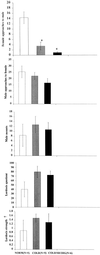Reproduction-related behaviors of Swiss-Webster female mice living in a cold environment
- PMID: 11136237
- PMCID: PMC14651
- DOI: 10.1073/pnas.98.2.700
Reproduction-related behaviors of Swiss-Webster female mice living in a cold environment
Abstract
Based on a molecular neuroendocrine theory about cold environments, thyroid hormone levels, and liganded thyroid hormone receptor interference with estrogen receptor function, experiments were designed to test female mouse reproductive behaviors in the cold. Because natural seasonal temperature declines would usually be associated with decreased photoperiods and reduced food supplies, we combined cold temperatures with short days and metabolic challenge. The simplest hypothesis was that lordosis quotients would be significantly reduced as a result of cold temperatures. That hypothesis was denied. Instead, female approaches to the stud male declined. Because cold temperatures also led to significant reductions of activity in locomotor wheels, a straightforward reduction of activity could explain the female's behavior during mating tests. We suggest that cold temperatures accompanied by reduced photoperiod and reduced metabolic fuel can reduce overall activity in female mice, thus indirectly blocking untimely reproductive behaviors.
Figures




Similar articles
-
Photoperiodic and pineal influences on estrogen-stimulated behaviors in female Syrian hamsters.Physiol Behav. 1993 Jul;54(1):19-28. doi: 10.1016/0031-9384(93)90038-h. Physiol Behav. 1993. PMID: 8327603
-
Effects of cold exposure on estrous behavior and neural estrogen receptor in Syrian hamsters.Physiol Behav. 1999 Jan 1-15;65(4-5):763-8. doi: 10.1016/s0031-9384(98)00224-8. Physiol Behav. 1999. PMID: 10073477
-
Temporal and spatial quantitation of nesting and mating behaviors among mice housed in a semi-natural environment.Horm Behav. 2002 Nov;42(3):294-306. doi: 10.1006/hbeh.2002.1823. Horm Behav. 2002. PMID: 12460589
-
Sensitization of sexual behaviors in ovariectomized Long-Evans rats is induced by a subthreshold dose of estradiol benzoate and attenuated by repeated copulation.Horm Behav. 2014 Sep;66(4):655-62. doi: 10.1016/j.yhbeh.2014.09.009. Epub 2014 Sep 22. Horm Behav. 2014. PMID: 25251978
-
Sexual differentiation: do males differ from females in behavioral sensitivity to gonadal hormones?Prog Brain Res. 1984;61:257-70. doi: 10.1016/S0079-6123(08)64440-4. Prog Brain Res. 1984. PMID: 6396705 Review. No abstract available.
Cited by
-
Impact of Cold Exposure on the Reproductive Function in Female Rats.Biomed Res Int. 2018 Nov 22;2018:3674906. doi: 10.1155/2018/3674906. eCollection 2018. Biomed Res Int. 2018. PMID: 30596088 Free PMC article.
-
Effects of cold environment exposure on female reproductive health and its regulatory mechanisms.Front Genet. 2025 Apr 9;16:1570053. doi: 10.3389/fgene.2025.1570053. eCollection 2025. Front Genet. 2025. PMID: 40270542 Free PMC article.
-
Effect of cold stress on ovarian & uterine microcirculation in rats and the role of endothelin system.Reprod Biol Endocrinol. 2020 Apr 14;18(1):29. doi: 10.1186/s12958-020-00584-1. Reprod Biol Endocrinol. 2020. PMID: 32290862 Free PMC article.
References
Publication types
MeSH terms
Substances
Grants and funding
LinkOut - more resources
Full Text Sources

